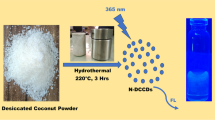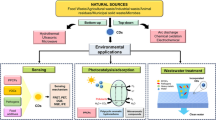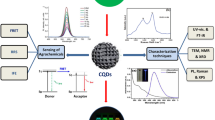Abstract
The synthesis of fascinating multifunctional carbon dots (CDs) attracted immense attention. Here, a facile solvothermal treatment of red pitaya peels in acetic acid produced CDs (designated as ACDs, excitation/emission wavelengths at 357/432 nm). ACDs with high sp2-hybridized carbon and carboxylic group contents can rapidly and selectively reduce Au3+ to Au0, and stabilize produced Au nanoparticles (AuNPs). The synergetic effect of electron transfer from ACDs to Au3+ and inner filter effect (IFE) from ACDs to AuNPs quenches the fluorescence within 30 s. Simultaneously, the resulting AuNPs have a purple color with a maximum absorption at 545 nm for visual detection. Therefore, for the first time, we reported a fluorometric and colorimetric dual-mode sensing system for real-time, highly sensitive and selective detection of Au3+. The fluorescence quenching ratio and absorbance change linearly with the increase of Au3+ concentration in the range of 0.3–8.0 μM and 3.3–60.0 μM with limits of detection (LODs) at 0.072 μM and 2.2 μM, respectively. The assay was applied for Au3+ determination in spiked real water samples with recoveries from 95.5 to 105.0%, and relative standard deviation (RSD) of less than 6.5%. Furthermore, ACDs with good photostability, low cytotoxicity, and excellent biocompatibility were successfully applied for intracellular Au3+ sensing and imaging. In addition, ACDs exhibited an extraordinarily high antioxidant activity, with an IC50 value for DPPH radical scavenging (0.70 μg mL−1) much lower than that of ascorbic acid (4.34 μg mL−1). The proposed strategy demonstrates the outstanding properties of ACDs in chemical and biomedical analysis.

Graphical abstract






Similar content being viewed by others
References
Ali HRH, Hassan AI, Hassan YF, EI-Wekil MM. Development of dual function polyamine-functionalized carbon dots derived from one step green synthesis for quantitation of Cu2+ and S2– ions in complicated matrices with high selectivity. Anal Bioanal Chem. 2020;412:1353–63.
Chandra S, Bano D, Pradhan P, Singh VK, Yadav PK, Sinha D, et al. Nitrogen/sulfur-co-doped carbon quantum dots: a biocompatible material for the selective detection of picric acid in aqueous solution and living cells. Anal Bioanal Chem. 2020;412:3753–63.
Peng B, Xu J, Fan M, Guo Y, Ma Y, Zhou M, et al. Smartphone colorimetric determination of hydrogen peroxide in real samples based on B, N, and S co-doped carbon dots probe. Anal Bioanal Chem. 2020;412:861–70.
Wu L, Long R, Li T, Tang C, Tong X, Guo Y, et al. One-pot fabrication of dual-emission and single-emission biomass carbon dots for Cu2+ and tetracycline sensing and multicolor cellular imaging. Anal Bioanal Chem. 2020;412:7481–9.
Naik VM, Gunjal DB, Gore AH, Anbhule PV, Sohn D, Bhosale SV, et al. Nitrogen-doped carbon dot threads as a “turn-off” fluorescent probe for permanganate ions and its hydrogel hybrid as a naked eye sensor for gold(III) ions. Anal Bioanal Chem. 2020;412:2993–3003.
Long R, Guo Y, Xie L, Shi S, Xu J, Tong C, et al. White pepper-derived ratiometric carbon dots for highly selective detection and imaging of coenzyme A. Food Chem. 2020;315:126171.
Abd Rani U, Ng LY, Ng CY, Mahmoudi E. A review of carbon quantum dots and their applications in wastewater treatment. Adv Colloid Interf Sci. 2020;278:102124.
Das R, Bandyopadhyay R, Pramanik P. Carbon quantum dots from natural resource: a review. Mater Today Chem. 2018;8:96–109.
Cui Y, Liu R, Ye F, Zhao S. Single-excitation, dual-emission biomass quantum dots: preparation and application for ratiometric fluorescence imaging of coenzyme A in living cells. Nanoscale. 2019;11:9270–5.
Long R, Tang C, Li T, Tong X, Tong C, Guo Y, et al. Dual-emissive carbon dots for dual-channel ratiometric fluoremetric determination of pH and mercury ion and intracellular imaging. Microchim Acta. 2020;187:307.
Joshi M, Prabhakar B. Phytoconstituents and pharmaco-therapeutic benefits of pitaya: a wonder fruit. J Food Biochem. 2020;44:e13260.
Liao J, Cheng Z, Zhou L. Nitrogen-doping enhanced fluorescent carbon dots: green synthesis and their applications for bioimaging and label-free detection of Au3+ ions. ACS Sustain Chem Eng. 2016;4:3053–61.
Raji K, Ramanan V, Ramamurthy P. Facile and green synthesis of highly fluorescent nitrogen-doped carbon dots from jackfruit seeds and its applications towards the fluorimetric detection of Au3+ ions in aqueous medium and in in vitro multicolor cell imaging. New J Chem. 2019;43:11710–9.
Ramanan V, Siddaiah B, Raji K, Ramamurthy P. Green synthesis of multifunctionalized, nitrogen-doped, highly fluorescent carbon dots from waste expanded polystyrene and its application in the fluorimetric detection of Au3+ ions in aqueous media. ACS Sustain Chem Eng. 2018;6:1627–38.
Chen Z, Wang S, Yang X. Phosphorus-doped carbon dots for sensing both Au(III) and L-methionine. J Photochem Photobiol A Chem. 2018;365:178–84.
Gu J, Hu D, Wang W, Zhang Q, Meng Z, Jia X, et al. Carbon dot cluster as an efficient “off–on” fluorescent probe to detect Au(III) and glutathione. Biosens Bioelectron. 2015;68:27–33.
Sharma V, Kaur N, Tiwari P, Saini AK, Mobin SM. Multifunctional fluorescent “Off-On-Off” nanosensor for Au3+ and S2- employing N-S co-doped carbon dots. Carbon. 2018;139:393–403.
Gao W, Zhou Y, Xu C, Guo M, Qi Z, Peng X, et al. Bright hydrophilic and organophilic fluorescence carbon dots: one-pot fabrication and multi-functional applications at visualized Au3+ detection in cell and white light-emitting devices. Sensor Actuat B: Chem. 2019;281:905–11.
Gao W, Song H, Wang X, Liu X, Pang X, et al. Carbon dots with red emission for sensing of Pt2+, Au3+, and Pd2+ and their bioapplications in vitro and in vivo. ACS Appl Mater Interf. 2018;10:1147–54.
Amjadi M, Shokri R, Hallaj T. A new turn-off fluorescence probe based on graphene quantum dots for detection of Au(III) ion. Spectrochim Acta A. 2016;153:619–24.
Zhu W, Zhou Y, Tao M, Yan X, Liu Y, Zhou X. An electrochemical and fluorescence dual-signal assay based on Fe3O4@MnO2 and N-doped carbon dots for determination of hydrogen peroxide. Microchim Acta. 2020;187:187.
Luo J, Shen X, Li B, Li X, Zhou X. Signal amplification by strand displacement in a carbon dot based fluorometric assay for ATP. Microchim Acta. 2020;185:392.
Tong X, Shi S, Tong C, Iftikhar A, Long R, Zhu Y. Quantum/carbon dots-based fluorescent assays for enzyme activity. Trend Anal Chem. 2020;131:116008.
Innocenzi P, Stagi L. Carbon-based antiviral nanomaterials: graphene, C-dots, and fullerenes. A perspective Chem Sci. 2020;11:6606.
Radnia F, Mohajeri N, Zarghami N. New insight into the engineering of green carbon dots: possible applications in emerging cancer theranostics. Talanta. 2020;209:120547.
Gao Q, Ma R, Chen L, Shi S, Cai P, Zhang S, et al. Antioxidant profiling of vine tea (Ampelopsis grossedentata): off-line coupling heart-cutting HSCCC with HPLC–DAD–QTOF-MS/MS. Food Chem. 2017;225:55–61.
Tong X, Li T, Long R, Guo Y, Wu L, Shi S. Determination of the activity of γ-glutamyl transpeptidase and of its inhibitors by using the inner filter effect on the fluorescence of nitrogen-doped carbon dots. Microchim Acta. 2020;187:182.
Li W, Zhang X, Miao C, Li R, Ji Y. Fluorescent paper–based sensor based on carbon dots for detection of folic acid. Anal Bioanal Chem. 2020;412:2805–13.
Haiss W, Thanh NTK, Aveyard J, Fernig DG. Determination of size and concentration of gold nanoparticles from UV-Vis spectra. Anal Chem. 2007;79:4215–21.
Ruiz V, Yate L, García I, Cabanero G, Grande HJ. Tuning the antioxidant activity of graphene quantum dots: protective nanomaterials against dye decoloration. Carbon. 2017;116:366–74.
Yang B, Zhang XB, Liu W, Hu R, Tan W, Shen G, et al. Fluorosurfactant-capped gold nanoparticles-based label-free colorimetric assay for Au3+ with tunable dynamic range via a redox strategy. Biosensor Bioeletron. 2013;48:1–5.
Zhao S, Lan M, Zhu X, Xue H, Ng TW, Meng X, et al. Green synthesis of bifunctional fluorescent carbon dots from garlic for cellular imaging and free radical scavenging. ACS Appl Mater Interf. 2015;7:17054–60.
Li D, Na X, Wang H, Xie Y, Cong S, Song Y, et al. Fluorescent carbon dots derived from maillard reaction products: their properties, biodistribution, cytotoxicity, and antioxidant activity. J Agric Food Chem. 2018;66:1569–75.
Lin JS, Tsai YW, Dehvari K, Huang CC, Chang JY. A carbon dot based theranostic platform for dual-modal imaging and free radical scavenging. Nanoscale. 2019;11:20917–31.
Funding
This work was supported by the National Natural Science Foundation of China (31660181), and the Natural Science Foundation of Hunan Province, China (2018JJ1043).
Author information
Authors and Affiliations
Corresponding authors
Ethics declarations
Conflict of interest
The authors declare that they have no conflict of interest.
Additional information
Publisher’s note
Springer Nature remains neutral with regard to jurisdictional claims in published maps and institutional affiliations.
Supplementary information
ESM 1
(PDF 815 kb)
Rights and permissions
About this article
Cite this article
Guo, Y., Li, T., Xie, L. et al. Red pitaya peels-based carbon dots for real-time fluorometric and colorimetric assay of Au3+, cellular imaging, and antioxidant activity. Anal Bioanal Chem 413, 935–943 (2021). https://doi.org/10.1007/s00216-020-03049-x
Received:
Revised:
Accepted:
Published:
Issue Date:
DOI: https://doi.org/10.1007/s00216-020-03049-x




